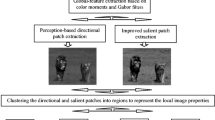Abstract
In traditional content-based image retrieval (CBIR) methods, features are extracted from the entire image for computing similarity with query. It is necessary to design a smart object-centric CBIR to retrieve images from the gallery, having objects similar to that present in the foreground of the query image. We propose a model for a novel SLAR (Simultaneous Localization And Recognition) framework for solving this problem of smart CBIR, to simultaneously: (i) detect the location and (ii) recognize the type (ID or class) of the foreground object in a scene. The framework integrates both unsupervised and supervised methods of foreground segmentation and object classification. This model is motivated by the cognitive models of human visual perception, which generalizes from examples to simultaneously locate and categorize objects. Experimentation has been done on six categories of objects and the results have been compared with a contemporary work on CBIR.
Access this chapter
Tax calculation will be finalised at checkout
Purchases are for personal use only
Preview
Unable to display preview. Download preview PDF.
Similar content being viewed by others
References
Baars, B.J., Gage, N.M.: Cognition, Brain, and Consciousness, Introduction to Cognitive Neuroscience. Academic Press (2010)
Boykov, Y., Funka-Lea, G.: Graph cuts and efficient n-d image segmentation. International Journal of Computer Vision 70, 109–131 (2006)
Canny, J.: A computational approach to edge detection. IEEE Transactions on Pattern Analysis and Machine Intelligence 8(6), 679–698 (1986)
Chang, C.C., Lin, C.-J.: Libsvm: A library for support vector machines (2001)
Cortes, C., Vapnik, V.: Support vector network. Machine Learning 20, 1–25 (1995)
Felzenszwalb, P.F., Girshick, R.B., McAllester, D.A., Ramanan, D.: Object detection with discriminatively trained part-based models. IEEE Transactions on Pattern Analysis and Machine Intelligence 32, 1627–1645 (2010)
http://research.microsoft.com/enus/projects/objectclassrecognition/
Leibe, B., Leonardis, A., Schiele, B.: Robust object detection with interleaved categorization and segmentation. International Journal of Computer Vision 27(1-3), 259–289 (2007)
Levin, A., Weiss, Y.: Learning to combine bottom-up and top-down segmentation. International Journal on Computer Vision 81, 105–118 (2009)
Lin, C.H., Chen, R.-T., Chan, Y.K.: A smart content-based image retrieval system based on color and texture feature. Image and Vision Computing 27(6), 658–665 (2009)
Liu, G.-H., Zhang, L., Hou, Y.-K., Li, Z.-Y., Yang, J.-Y.: Image retrieval based on multi-texton histogram. Pattern Recognition 43, 2380–2389 (2010)
Rahman, M. M., Bhattacharya, P., Desai, B.C.: A unified image retrieval framework on local visual and semantic concept-based feature spaces. Journal of Visual Communication and Image Representation 27, 658–665 (2009)
Rother, C., Kolmogorov, V., Blake, A.: Grabcut: Interactive foreground extraction using iterated graph-cuts. ACM Transactions on Graphics 23(3), 309–334 (2004)
Wang, J.Z., Li, J., Wiederhold, G.: SIMPLICITY: semantics sensitive integrated matching for picture libraries. IEEE Transactions on Pattern Analysis and Machine Intellegence 23, 947–963 (2001)
Wu, Y., Wu, Y.: Shape-based image retrieval using combining global and local shape features. In: 2nd International Congress on Image and Signal Processing, pp. 1–5 (October 2009)
Author information
Authors and Affiliations
Editor information
Editors and Affiliations
Rights and permissions
Copyright information
© 2012 Springer-Verlag Berlin Heidelberg
About this paper
Cite this paper
Dwivedi, G., Das, S., Rakshit, S., Vora, M., Samanta, S. (2012). SLAR (Simultaneous Localization And Recognition) Framework for Smart CBIR. In: Kundu, M.K., Mitra, S., Mazumdar, D., Pal, S.K. (eds) Perception and Machine Intelligence. PerMIn 2012. Lecture Notes in Computer Science, vol 7143. Springer, Berlin, Heidelberg. https://doi.org/10.1007/978-3-642-27387-2_35
Download citation
DOI: https://doi.org/10.1007/978-3-642-27387-2_35
Publisher Name: Springer, Berlin, Heidelberg
Print ISBN: 978-3-642-27386-5
Online ISBN: 978-3-642-27387-2
eBook Packages: Computer ScienceComputer Science (R0)




